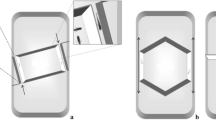Abstract
Recent research supports a significant role for prenatal sensory experience in the development of lateralized postnatal visual discrimination in birds, but little is known about its potential effect on the development of lateralized postnatal motor behaviors. Therefore, the present study examined the effects of prenatal visual experience on the development of spatial turning bias in domestic chicks. Control tests with maternally naive, domestic chicks in a standard T maze revealed a left-side turning bias in 90% of subjects. Such large population biases are considered unusual in nonhuman species. Chicks were exposed to one of three prenatal conditions: both eye systems exposed to enhanced visual experience, right-eye system exposed/left-eye system occluded, or left-eye system exposed/right-eye system occluded. Results revealed a significant lack of population turning bias in all experimental subjects except those that received right eye stimulation prenatally. These results suggest that unilateral prenatal visual experience to the right eye/left hemisphere is a significant contributor to the lateralization process in domestic chicks.
Similar content being viewed by others
References
BRADSHAW, J., & ROGERS, L. (1993). The evolution of lateral asymmetries, language, tool use, and intellect (pp. 36–158). New York: Academic Press.
BRADSHAW, J. L., & BRADSHAW, J. A. (1988). Rotational and turning tendencies in humans: An analog of lateral biases in rats? International Journal of Neuroscience, 39, 229–232.
CASEY, M. B., & LICKLITER, R. (1996). Effects of siblings on behavioral responsiveness to a maternal alarm call in bobwhite quail chicks (Colinus virginianus). Bird Behavior, 11, 17–24.
CORBALLIS, M. C. (1991). The lopsided ape. New York: Oxford University Press.
COWEN, W. M., ADAMSON, L., & POWELL, T. P. (1961). An experimental study of the avian visual system. Journal of Anatomy, 95, 545–563.
DENENBERG, V. H. (1977). Assessing the effects of early experience. In R. D. Myers (Ed.), Methods of psychobiology (pp. 127–147). New York: Academic Press.
DENENBERG, V. H. (1981). Hemispheric laterality in animals and the effects of early experience. The Behavioral and Brain Sciences, 4, 1–49.
DENENBERG, V. H., GARBANATI, J., SHERMAN, G., YUTZEY, D. A., & KAPLAN, R. (1978). Infantile stimulation induces brain lateralization in rats. Science, 201, 1150–1151.
GLICK, S. D. (1985). Heritable differences in turning behavior in rats. Life Sciences, 36, 499–503.
GOSPE, S. M., MORA, B. J., & GLICK, S. D. (1990). Measurement of spontaneous movement (circling) in normal children. Journal of Child Neurology, 5, 31–34.
HEATON, M. B., & GALLEHER, E. (1981). Prenatal auditory discrimination in the bobwhite quail. Behavioral and Neural Biology, 31, 242–246.
KUO, Z.-Y. (1967). Dynamics of behavior development. New York: Random House.
LICKLITER, R. (1990). Premature visual stimulation alters intersensory functioning in bobwhite quail neonates. Developmental Psychobiology, 23, 15–27.
MELEKIAN, B. (1981). Lateralization in the newborn at birth: Asymmetry of the stepping reflex. Neuropsychologia, 19, 707–711.
OPPENHEIM, R. (1972). Prehatching and hatching behaviors in birds: A comparative study of altricial and precocial species. Animal Behavior, 20, 644–655.
RIDGEWAY, S. H. (1986). Physiological observation on dolphins’ brains. In R. Schusterman, J. A. Thomas, & F. G. Wood (Eds.), Dolphin cognition and behavior: A comparative approach (pp. 31–60). Hillsdale, NJ: Erlbaum.
ROGERS, L. J. (1982). Light experience and asymmetry of brain function in chickens. Nature, 297, 223–225.
ROGERS, L. J. (1991). Development of lateralization. In R. J. Andrew (Ed.), Neural and behavioral plasticity. Oxford: Oxford University Press.
ROGERS, L. J., & BOLDEN, S. W. (1991). Light-dependent development and asymmetry of visual projections. Neuroscience Letters, 121, 63–67.
ROGERS, L. J., & WORKMAN, L. (1989). Light exposure during incubation affects competitive behaviour in domestic chicks. Applied Animal Behavior Science, 23, 187–198.
SCHÖNE, H. (1984). Spatial orientation. Princeton, NJ: Princeton University Press.
VINCE, M. A. (1972). Communication between quail embryos and the synchronization of hatching. Proceedings of the XV International Ornithological Congress, 357–362.
WARREN, J. M. (1977). Handedness and cerebral dominance in monkeys. In S. Harnad, R. Doty, L. Goldstein, J. Jaynes, & G. Krauthamer (Eds.), Lateralization in the nervous system (pp. 151–172). New York: Academic Press.
WESTERGAARD, G. C., & SUOMI, S. J. (1996). Lateral bias for rotational behavior in tufted capuchin monkeys (Cebus apella). Journal of Comparative Psychology, 110(2), 199–202.
ZAPPIA, J. V., & ROGERS, L. J. (1983). Light experience during development affects asymmetry of forebrain function in chickens. Developmental Brain Research, 11, 93–106.
ZAPPIA, J. V., & ROGERS, L. J. (1987). Sex differences and reversal of brain asymmetry by testosterone in chickens. Behavioural Brain Research, 23, 261–267.
Author information
Authors and Affiliations
Rights and permissions
About this article
Cite this article
Casey, M.B., Karpinski, S. The Development of Postnatal Turning Bias is Influenced by Prenatal Visual Experience in Domestic Chicks (Gallus gallus). Psychol Rec 49, 67–74 (1999). https://doi.org/10.1007/BF03395307
Published:
Issue Date:
DOI: https://doi.org/10.1007/BF03395307




